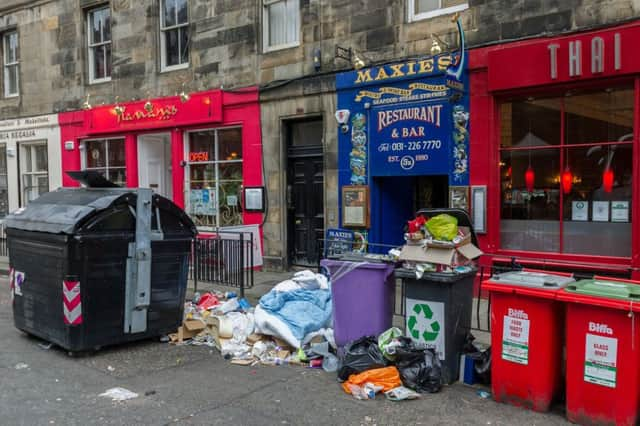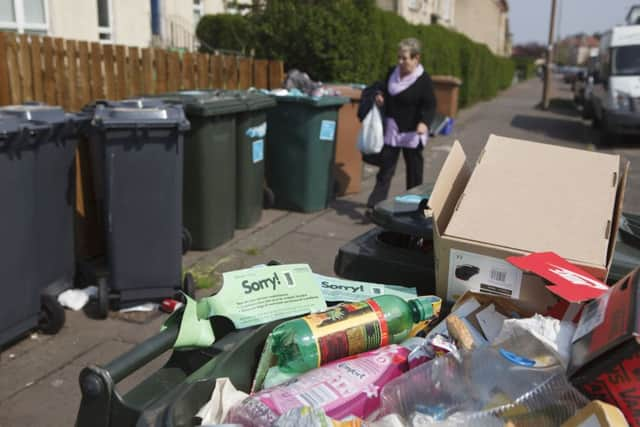Official study reveals City's dirtiest streets


A litter survey found 92 per cent of city streets passed the cleanliness test in September – compared with 98 per cent of streets in March last year.
The latest “clean” rating – based on a random sample of streets in each ward across the city – falls short of the council’s own target of 95 per cent.
Advertisement
Hide AdAdvertisement
Hide AdTen out of the 17 wards achieved the 95 per cent target and three scored 100 per cent.


But Leith Walk emerged with the lowest percentage of clean streets – just 67 per cent – followed by Sighthill/Gorgie on 75 per cent and Southside/Newington on 83 per cent.
Advertising consultant and Evening News columnist Gerry Farrell, who heads the Litter Free Leith campaign, was not surprised at which area came out worst.
He said: “Leith Walk itself is kept quite sparkling, I’d say, but if you turn right or left down one of the side streets it’s almost as if they don’t see the cleaning vehicles.
Advertisement
Hide AdAdvertisement
Hide Ad“Some of the longest days we’ve had picking up litter have been in the side streets off Leith Walk. You can tell it’s not fresh litter – it’s been there for a while.


“And you can tell a lot of it comes from drivers just emptying the footwell of their car into the gutter. It’s a real scourge of the city – people can bring their car into your area and just decide to dump their rubbish in the street.
“It’s a filthy habit, far worse than dropping a Mars Bar wrapper.
“I would love there to be more CCTV cameras to catch the people who do it – and stencils on the kerb saying something like ‘You can park your car here but not your rubbish’.”
Advertisement
Hide AdAdvertisement
Hide AdThe latest figures, in a report to the city council’s environment committee, come as the Evening News continues its Bin Watch campaign to highlight the problem of overflowing bins across the Capital.
Deborah Charlesworth, secretary of Southside Community Council, said personally she felt there was a real problem with litter in her area.
“The Southside is certainly very dirty, with a lot of litter, and this is a problem, making the area appear unappealing, and giving the impression that the residents don’t mind being dirty, which is not the case at all.
“Much of the mess comes from takeaway eating places, and there are also problems from people drinking and vomiting, and the problems are compounded by antisocial dumping of bottles – despite the provision of excellent bins to recycle them – and by landlords and builders leaving large items by the street bins.
Advertisement
Hide AdAdvertisement
Hide Ad“The bins are also not emptied often enough, and frequently overflow, and of course many bins are now old and battered, adding to the bad impression.”
Keep Scotland Beautiful, who carried out the survey, examined a total of 507 different 50-metre sections of street to reach their cleanliness verdicts.
And they graded each section from A to D for the presence of litter.
Only four out of the 72 samples in the central area were graded C or D – below the acceptable standard of cleanliness – while of the 40 C and D graded samples across the city, 36 were in residential areas.
Advertisement
Hide AdAdvertisement
Hide AdSix streets were given a D grade – “heavily littered” – Moredunvale Bank, Sighthill Gardens, Newhaven Road, Bridge Road in Colinton, Barn Park Crescent and Pennywell Road.
Out of 323 open space locations visited, 23 were found to be grade C – significantly littered – but only one, open space at Admiralty Street in Leith, was graded D.
Smoking-related litter was found in 62.8 per cent of the streets and open spaces surveyed – up from 53.3 per cent in 2014/15 – mostly in the city centre and high-density residential areas.
However, the report said there was no evidence this year of business-generated litter in city centre locations, an improvement on the 2014/15 results.
Advertisement
Hide AdAdvertisement
Hide AdAnd there appears to have been an improvement on people picking up after their dogs.
Complaints about dog fouling received by environmental wardens between April and September this year totalled 438 – a 31 per cent reduction compared to the 639 complaints recorded during the same period in 2015.
Some 31 fixed penalty notices were issued for dog fouling during the six months to September, one less than in the same period the previous year.
Figures show the council is falling well short of its target for responding to inquiries from the public on litter, fly-tipping, dog fouling, overflowing bins and other waste issues.
Advertisement
Hide AdAdvertisement
Hide AdThe aim is to deal with 85 per cent of the complaints within an agreed timescale – 24 hours for dog fouling or overflowing bins, ten days for fly-tipping – but in September just 60 per cent were cleared up within the target.
A total of 1851 inquiries were received in September – 25 per cent down from the previous month. Fly-tipping was the most common complaint with 687, followed by litter (613) and dog fouling (135).
The council said the shortfall in performance against target could be accounted for in part by the transition to a new management structure. It added: “Now that the new management structure is in place performance should improve.”
The report says 350 litter bin sensors are currently being piloted on one collection route of street litter bins. Information on how full the bins are allows a collection route to be planned, based on those bins that are 80 per cent full or more at 5am every day. The sensors can also identify bins that are predicted to be 80 per cent full over the next 24-hour period.
Advertisement
Hide AdAdvertisement
Hide AdAnd combined with in-cab technology, they allow drivers to follow a route via satellite navigation, turn by turn, bin by bin.
The report says: “This is expected to deliver higher levels of efficiency.”
Green environment spokesman Councillor Chas Booth said: “There is no doubt in my mind the council could and should be doing a lot more.
“It’s one of the most basic functions of the council to lift bins on time and keep the streets free of litter and we need to get better at doing it.”
Advertisement
Hide AdAdvertisement
Hide AdHe said the Greens had put forward a number of proposals, including a drive to discourage people from dropping litter.
“We want to see more environmental wardens so there is more chance of someone getting caught and issued with a fine if they drop litter,” he said. “If people get a fine they are much less likely to drop litter again.”
The council said its street cleansing service and environmental wardens had been brought together with waste and recycling into one department to promote a more integrated approach to litter and waste.
Environment convener Councillor Lesley Hinds said the level of littering recorded by the survey would always go up and down.
Advertisement
Hide AdAdvertisement
Hide Ad“It gives an idea of what the cleanliness of each area is, but it is only a snapshot at a certain time. It gives us an impression and if necessary we will look to see if we can put in extra resources to a particular area.
“There will always be some areas that are better than others. But we want to keep every street as clean as possible.”
She said the council’s new 65-point action plan to crack down on the Capital’s rubbish problem included extra resources and new equipment for street cleaning.
But she added: “If people didn’t drop litter in the street we wouldn’t have the same problem.”